|
|
|
Sort Order |
|
|
|
Items / Page
|
|
|
|
|
|
|
| Srl | Item |
| 1 |
ID:
157584
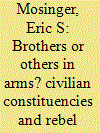

|
|
|
|
|
| Summary/Abstract |
Why do united rebel fronts emerge in some insurgencies, while in other insurgencies multiple rebel groups mobilize independently to challenge the state, and often, each other? I develop a diffusion model of rebel fragmentation in which participation in rebellion spreads, completely or incompletely, through networks of civilians and dissidents. Using this theoretical framework I hypothesize that two factors jointly determine whether a rebel movement remains unified or fragments: the rebels’ investment in civilian mobilization, and the overall level of civilian grievances. The theory predicts that widely shared grievances motivate the formation of many small dissident groups willing to challenge the regime. Given the difficulty of collective action between disparate opposition actors, an emerging rebel movement will tend towards fragmentation when popular grievances are high. Yet extremely high civilian grievances can also help rebels activate broad, overlapping civilian social networks that serve to bridge together dissident groups. Mass-mobilizing rebel groups, benefiting from the participation of broad civilian networks, are most likely to forge and maintain a unified rebel front. I test this theory alongside several alternatives drawn from cross-national studies of conflict using regression analysis. The quantitative evidence lends considerable credence to the role of rebel constituencies in preventing or fomenting rebel fragmentation.
|
|
|
|
|
|
|
|
|
|
|
|
|
|
|
|
| 2 |
ID:
193110
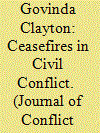

|
|
|
|
|
| Summary/Abstract |
Ceasefires are arrangements through which conflict parties commit to stop fighting. They are a common part of intra-state conflict. Existing research on intra-state ceasefires is largely limited to case studies and guidance notes for the policy and practice community. What has to date been lacking is a complementing body of comparative quantitative analysis to identify broader ceasefire trends and test the wider applicability of theory. Recent advancements in ceasefire data offer new opportunities to broaden the research agenda on ceasefires. This special section sets out the current state of the art in ceasefire research and provides the intellectual foundations to advance a new sub-field of quantitative ceasefire research. We discuss the conceptual challenges facing the study of ceasefires, offer a brief overview of ceasefire research focusing on the functions, timing, and sustainability of arrangements, and discuss the collective contributions of the articles included within this special section, and the implications for research and practice.
|
|
|
|
|
|
|
|
|
|
|
|
|
|
|
|
| 3 |
ID:
176095
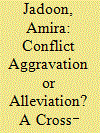

|
|
|
|
|
| Summary/Abstract |
MILITARY AID RELATIONSHIPS ALLOW DONORS to avoid direct intervention and delegate the practical execution of their security goals to recipients. But recipients often fall short of meeting the security objectives that underpin military aid. Pakistan, which has received large amounts of military aid from the United States since September 11, 2001, has been consistently criticized by U.S. administrations for failing to do enough to dismantle terrorist networks. In 2018, the Donald Trump administration finally announced its decision to halt all security aid to Pakistan for playing a duplicitous role and providing sanctuaries to terrorists.1
|
|
|
|
|
|
|
|
|
|
|
|
|
|
|
|
| 4 |
ID:
151067
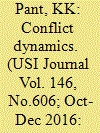

|
|
|
|
|
| Summary/Abstract |
Conflicts happen, leaving tangled stomachs, crumpled brows, shaky knees. They strain us and stretch us. To address conflicts constructively, we need intuition and imagination to navigate the shades of conflict. In this article, I wish to examine the dynamics of conflict process. Conflicts do not arise simply because of differences over issues or miscommunication. Some of the most difficult conflicts, we face today have well-defined issues and have been the subject of countless efforts at calm communications. In the words of Bo Kjellen, the Swedish negotiator to the Kyoto Protocol, “I only knew negotiations through my practical experience and started to read the theory only towards the end of my career. I think it would have helped me a lot had I known the theory earlier”.
|
|
|
|
|
|
|
|
|
|
|
|
|
|
|
|
| 5 |
ID:
082403
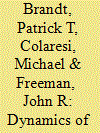

|
|
|
|
|
| Publication |
2008.
|
| Summary/Abstract |
Do public opinion dynamics play an important role in understanding conflict trajectories between democratic governments and other rival groups? The authors interpret several theories of opinion dynamics as competing clusters of contemporaneous causal links connoting reciprocity, accountability, and credibility. They translate these clusters into four distinct Bayesian structural time series models fit to events data from the Israeli-Palestinian conflict with variables for U.S. intervention and Jewish public opinion about prospects for peace. A credibility model, allowing Jewish public opinion to influence U.S., Palestinian, and Israeli behavior within a given month, fits best. More pacific Israeli opinion leads to more immediate Palestinian hostility toward Israelis. This response's direction suggests a negative feedback mechanism in which low-level conflict is maintained and momentum toward either all-out war or dramatic peace is slowed. In addition, a forecasting model including Jewish public opinion is shown to forecast ex ante better than a model without this variable
|
|
|
|
|
|
|
|
|
|
|
|
|
|
|
|
| 6 |
ID:
159251
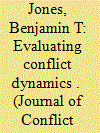

|
|
|
|
|
| Summary/Abstract |
Interest in processes has become increasingly pronounced in international conflict research in recent years, especially how these processes unfold across time “dynamics”. We focus in particular on “stage conceptions” of dynamics: processes that unfold over a series of sequential, and possibly recurrent, stages. We suggest that stage conceptions have two key properties: plurisectality and conditional covariate effects. We propose a novel econometric application to quantitatively assess claims regarding stage conceptions of dynamics: survival modeling. Specifically, we use multistate models to examine how a process evolves through its individual stages, and also whether covariate effects differ across these stages. We use Huth and Allee’s territorial dispute data to demonstrate the importance of conceptualizing conflict as a dynamic process, as well as empirically modeling it as such. We show democracy has different effects on dispute resolution, depending on the dispute’s stage, but that these different effects disappear after time passes.
|
|
|
|
|
|
|
|
|
|
|
|
|
|
|
|
| 7 |
ID:
090437
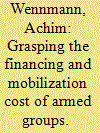

|
|
|
|
|
| Publication |
2009.
|
| Summary/Abstract |
This paper approaches conflict financing as a combination of available revenue sources and the cost to start and maintain armed conflict. The paper therefore goes beyond conceptualizations of conflict financing that only look at the total available revenue of armed groups. Based on recent small arms research, the paper sketches a tool to estimate the mobilization cost of armed groups with the objective to establish data points for barriers to entry into armed conflict and the cost of competition during armed conflict. The paper argues that what matters in conflict financing is to identify the financing and mobilization costs together, and if an armed group can pay for the type of conflict required to reaching its objective. The paper contributes to an evolving literature on the feasibility of conflict and provides a new perspective on conflict dynamics with implications for peace processes, peacebuilding, and policy against conflict financing.
|
|
|
|
|
|
|
|
|
|
|
|
|
|
|
|
| 8 |
ID:
193116


|
|
|
|
|
| Summary/Abstract |
This article introduces the Civil Conflict CeaseFire (CF) dataset. The CF data covers all ceasefires in civil conflict between 1989 and 2020, including multilateral, bilateral and unilateral arrangements, ranging from verbal arrangements to detailed written agreements. In total, the CF data includes 2202 ceasefires across 66 countries and 109 civil conflicts. The data feature information on the actors involved in the ceasefire, and the class, purpose, coverage, and end date of the ceasefire. The CF data provide an empirical basis to assess the conditions that give rise to ceasefires, how ceasefires affect the dynamics of conflict, and the role of a ceasefire in the peace process. This article presents the rationale underlying the data collection, the coding rules and procedures, and how this data can be used for analysis.
|
|
|
|
|
|
|
|
|
|
|
|
|
|
|
|
| 9 |
ID:
171780
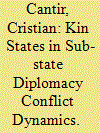

|
|
|
|
|
| Summary/Abstract |
How and why do diplomatic activities by sub-state units produce conflict with the central government? To answer this question, scholars have focused on multinational states in which at least one administrative unit—Catalonia, for instance—has an identity that is different from the rest of the country. Such noncentral governments (NCGs), the argument goes, are more likely to engage in uncoordinated bypassing activities and in the international projection of their specific identity in a manner that antagonizes central decision makers. That is especially the case if local elites are dissatisfied with the amount of local autonomy and the institutional tools available for identity protection. This article uses insights from the ethnic conflict and nationalism literature to advance sub-state diplomacy scholarship by adding a transnational dimension to the analysis. Three illustrative case studies—France-Canada-Quebec, Austria-Italy–South Tyrol, and Sweden-Finland–the Åland Islands—reveal that kin states can play a variety of roles in the triangular relationship with the kin NCG and the host state and can either exacerbate or dampen conflictual paradiplomacy. More broadly, the article is an effort to conceptualize the role of sovereign states in sub-state diplomacy.
|
|
|
|
|
|
|
|
|
|
|
|
|
|
|
|
| 10 |
ID:
167278
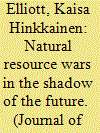

|
|
|
|
|
| Summary/Abstract |
Previous studies on natural resources and civil wars find that the presence of natural resources increases both civil conflict risk and duration. At the same time, belligerents often cooperate over resource extraction, suggesting a temporal variation in the contest over this subnational space. This study argues that parties fight over natural resources primarily when they expect that the conflict is about to end, as the importance of controlling them increases in the post-conflict setting. In contrast, belligerents that anticipate a long war have incentives to avoid fighting near natural resources since excessive violence will hurt the extraction, trade, and subsequent taxation that provide conflict actors with income from the resource. We test our argument using yearly and monthly grid-cell-level data on African civil conflicts for the period 1989–2008 and find support for our expected spatial variation. Using whether negotiations are underway as an indicator about warring parties’ expectations on conflict duration, we find that areas with natural resources in general experience less intense fighting than other areas, but during negotiations these very areas witness most of the violence. We further find that the spatial shift in violence occurs immediately when negotiations are opened. A series of difference-in-difference estimations show a visible shift of violence towards areas rich in natural resources in the first three months after parties have initiated talks. Our findings are relevant for scholarship on understanding and predicting the trajectories of micro-level civil conflict violence, and for policymakers seeking to prevent peace processes being derailed.
|
|
|
|
|
|
|
|
|
|
|
|
|
|
|
|
| 11 |
ID:
133703
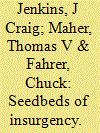

|
|
|
|
|
| Publication |
2014.
|
| Summary/Abstract |
Studies of insurgency and collective action are divided between structural and dynamic explanations. Structural theories address the presence of insurgency while dynamic theories focus on the frequency of insurgent actions. Yet prior studies often treat these arguments additively, leaving unclear how structural and dynamic processes affect these different aspects of insurgency. This study addresses this division by using zero-inflated negative binomial regression to examine in a single equation both the presence and the count of Islamist insurgency in Egyptian governorates between 1986 and 1999. We test political economy, moral economy, and cultural clash explanations of the presence of insurgency alongside political dynamics arguments about repression and exclusion to explain the count of attacks. Looking at the structural side of this equation, we find that communities with high rates of poverty, child mortality, cultural conservatism in terms of low contraceptive prevalence, and greater urban density are more likely to support insurgency. Looking at the dynamic side, parliamentary exclusion, security sweeps, and executions affect the count of attacks along with spatial diffusion from neighboring governorates. The culturally conservative region of Upper Egypt, which has a history of social and political marginality and opposition, provided a seedbed of insurgent support but this challenge broke down over time as repression intensified and exclusion was relaxed. These findings underscore the point that the presence of and the intensity of insurgency are distinct and driven by different factors. There are notable methodological and theoretical advantages to distinguishing between presence and count to better understand when and where insurgencies develop and their level of collective action.
|
|
|
|
|
|
|
|
|
|
|
|
|
|
|
|
| 12 |
ID:
159901
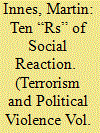

|
|
|
|
|
| Summary/Abstract |
This article provides a case study analysis of social reactions to the murder of Fusilier Lee Rigby in 2013. Informed by empirical data collected by systematic monitoring of social media platforms, the analysis identifies a number of online behaviours with offline effects—labeled the ten “Rs”—that collectively constitute the process of social reaction to the crime. These are defined as: reporting; requesting; responding; recruiting; “risking”; retaliating; rumouring; remembering; reheating; and “resiliencing”. It is argued that the ability to observe these behaviours through the application of qualitative social media analysis has considerable potential. Conceptually, the analysis provides new insight into the complex and chaotic processes of sense-making and meaning attribution that arise in the aftermath of terrorist attacks. It illuminates how patterns of social reaction on social media are nuanced and complicated, with different segments of the public interpreting the same developments very differently. In addition, the findings and the conceptual framework outlined have implications for policy and practice development in terms of establishing a more effective and evidence-based approach to the consequence management of “post-event” conflict dynamics and social reactions.
|
|
|
|
|
|
|
|
|
|
|
|
|
|
|
|
| 13 |
ID:
163162
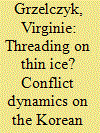

|
|
|
|
|
| Summary/Abstract |
In 2018, both the Republic of Korea (ROK) and the Democratic People’s Republic of Korea (DPRK) will mark the 70th anniversary of the establishment of their separate governments. This is a sad reminder that much remains frozen on the Korean Peninsula. For one, families have been separated and communication channels between the two Korean populations are almost non-existent. Yet, stability is precariously established by an Armistice that was signed in 1953 and that was never replaced by a permanent peace mechanism. Moreover, North Korea’s rapid nuclear development has contributed to tensions and uncertainties, and the Six-Party Talks, originally designed to ensure the denuclearisation of the peninsula, has been at a standstill for almost 10 years. The Korean story is thus a prime case to study the dynamics of a frozen conflict and this article contributes to the existing literature and analysis of frozen conflicts by suggesting looking at peaceful and violent thawing, as well as conflict withering. In order to so, the paper focuses on three crucial levels: (1) the micro level, the impact of the Armistice in light of today’s Koreas as opposed to their status and standing at the end of the Korean War in 1953, (2) the meso level with geostrategic concerns concentrated over sectorial policies surrounding the Korean Peninsula in a globalised world, and (3) the macro level with the changing nature of security governance. It is argued that in a catch-22 motion, the thread of violent thawing maintains the conflict in its frozen state.
|
|
|
|
|
|
|
|
|
|
|
|
|
|
|
|
| 14 |
ID:
098446
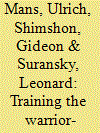

|
|
|
|
|
| Publication |
2010.
|
| Summary/Abstract |
Despite the wealth of experience among simulation scholars, there is still little consensus on how to link gaming attributes to specific learning objectives. This article aims to contribute to this discussion and argues that specific simulation design can lead to reaching pre-defined learning objectives. The authors present a teaching project developed and executed for the Netherlands Defense Academy, how it was set up in 2005, and the way it evolved over time. The authors discuss how the methodology fits into the academic debate on the strengths of experiential learning. The simulation methodology used is rooted in experiential learning and typically supports standard learning goals and styles. When dealing with a specific target group, it is possible to pinpoint one specific, overarching learning objective. This allows trainers to link each individual aspect of the simulation design to that particular learning goal and, in turn, provides a valuable framework to develop, run and evaluate simulation exercises. The authors discuss how two innovative elements in simulating gaming can help to make such an approach work: combining closed and open scenarios, and new communication software that allows for continuous supervision during the game. The conclusions discuss how students respond to the challenges during the game and what the data from debriefings tells us about the methodology's learning appeal for a military target group.
|
|
|
|
|
|
|
|
|
|
|
|
|
|
|
|
| 15 |
ID:
109934
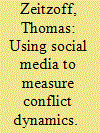

|
|
|
|
|
| Publication |
2011.
|
| Summary/Abstract |
The lack of temporal disaggregation in conflict data has so far presented a strong obstacle to analyzing the short-term dynamics of military conflict. Using a novel data set of hourly dyadic conflict intensity scores drawn from Twitter and other social media sources during the Gaza Conflict (2008-2009), the author attempts to fill a gap in existing studies. The author employs a vector autoregression (VAR) to measure changes in Israel's and Hamas's military response dynamics immediately following two important junctures in the conflict: the introduction of Israeli ground troops and the UN Security Council vote. The author finds that both Hamas's and Israel's response to provocations by the other side increase (both by about twofold) immediately after the ground invasion, but following the UN Security Council vote, Israel's response is cut in half, while Hamas's slightly increases. In addition, the author provides a template for researchers to harness social media to capture the micro-dynamics of conflict.
|
|
|
|
|
|
|
|
|
|
|
|
|
|
|
|
| 16 |
ID:
193112
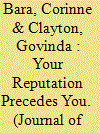

|
|
|
|
|
| Summary/Abstract |
How does the state’s behavior in negotiations with one non-state group influence the behavior of other non-state actors? We argue that the dynamics of different conflicts within the same country are interdependent, and that a state develops a reputation through its interactions with each conflict party. This reputation provides a valuable source of information that other groups use to judge the state’s cooperative intentions. When a state develops a reputation for cooperation, this increases the likelihood of (indirect) reciprocation from other groups. More specifically, we argue that when states enter into (and honor) a ceasefire with one rebel group, they demonstrate a credible reputation for cooperation. A credible reputation for cooperation, we posit, increases the likelihood that other conflict parties enter into ceasefires with the state, or that they de-escalate their military activities. We test our claims using the new civil conflict ceasefire dataset and find support for our argument.
|
|
|
|
|
|
|
|
|
|
|
|
|
|
|
|
|
|
|
|
|